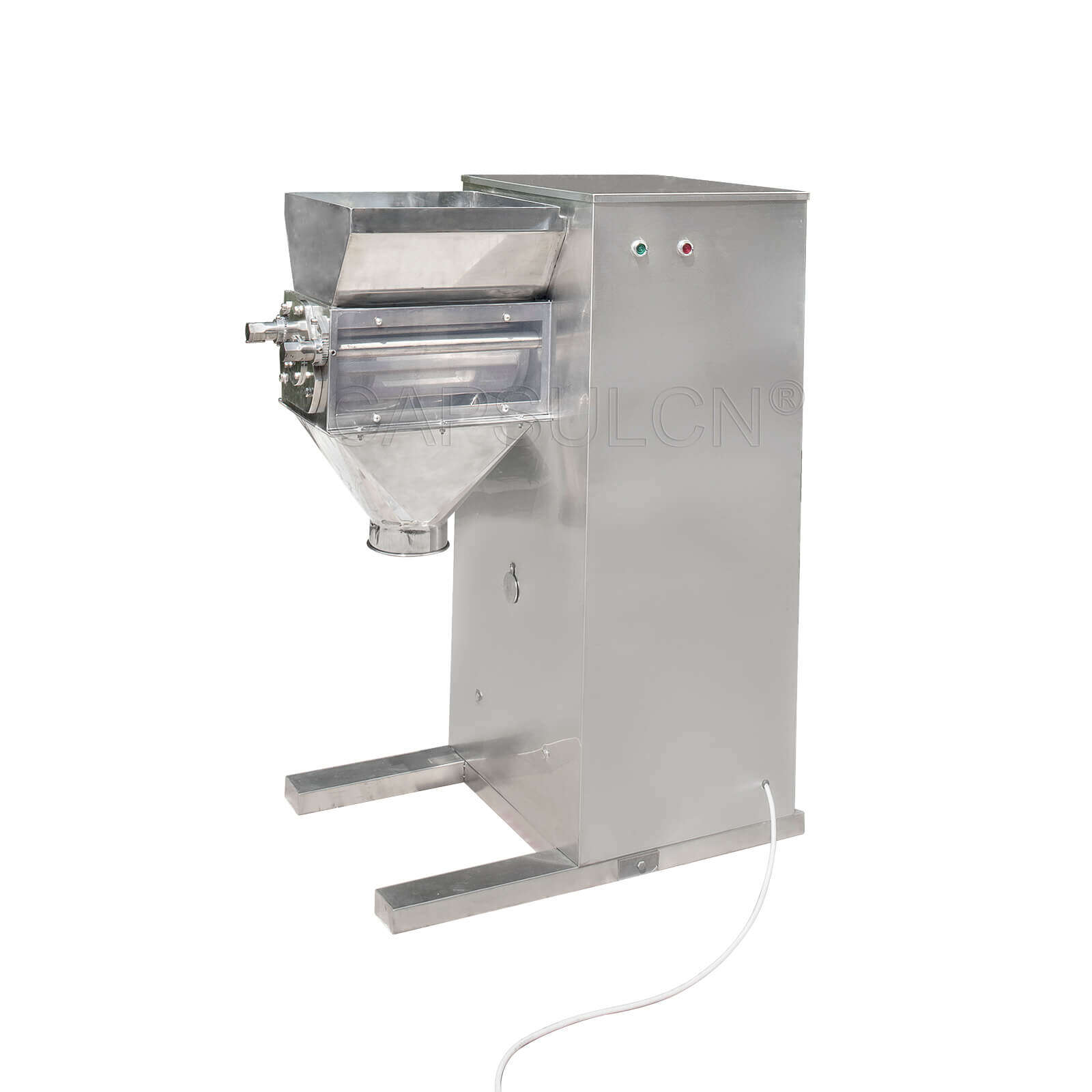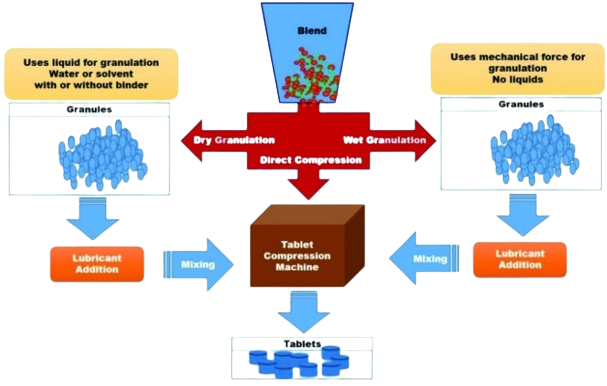An Overview of the Dry Granulation Process
If you're involved in the process manufacturing, there is a technology you need to be familiar with - Dry Granulation. What is this processing method? How does it work? Why do we use it in the process industries?
This article will give you a comprehensive insight into dry granulation. We will discuss its definition, advantages and disadvantages, and typical applications. Let's get started!
What is dry granulation?
Before diving into the dry granulation definition, let's first figure out what granulation is.
As you know, one of the first steps in making tablets or capsules is to create a homogeneous blend of ingredients. Compared to bulk powders, granular materials flow better and are easier to handle. They also don't stick together as much, even after being stored for a long time.

Granulation is an effective way to form granular materials from a powdered or solid substance. Generally, there are two types of granulation methods: dry granulation and wet granulation.
As the name implies, dry granulation is a process performed without adding any liquids. This method is done for ingredients that are sensitive to moisture and heat. Since no liquid binder is used, the process won't change the chemical composition. So, the dry granulation method is the preferred option for compacting chemical raw materials into granules.
Types of dry granulation
Typically, dry granulation can be done in two ways: either by roller compaction or by slugging.
Dry granulation by roller compaction
Roller compaction is a widely used dry granulation method. This method compacts dry powders into a solid mass known as a ribbon. The ribbon is then broken up into the intended sizes using a milling system. This makes the powder particles stick together to form granules.

In dry granulation by roller compaction, a powder blend is compacted by applying high pressure on the powder to increase the size of the granule.
The roller compaction method transports the powder blend to a pair of counter-rotating rollers. This can be done using either gravity or an auger feed system. As the powder runs into the gap between the rollers, the gap diameter gets smaller.
To increase the bulk density and homogeneity, you should make sure that the gap between the rollers is controlled and that the powder blend is compacted by the given force.
In a nutshell, the powder feeding, the applied compaction pressure, and the gap diameters are the most important factors in the roller compaction process.
Slugging process in dry granulation
Slugging is another form of dry granulation. It is also known as precompression or double compression. This cost-effective dry granulation method also works well for raw materials that are sensitive to heat and moisture.

The powdered solids are mixed and then pressed into flat-faced large-sized tablets (slugs) on a conventional tablet press. The process is performed without using heat or solvents. Then, the slugs are milled into granules.
Yet, since solids with low bulk density and small particles generally don't flow well into the tablet press die, the slug weights vary. This causes big changes in the force applied to each slug. So, the properties of the granules that are made by milling the slugs can't be controlled well either.
Because of this, slugging isn't used as often as it used to be as a way to make dry granules.
Dry granulation steps
Though both roller compaction and slugging are dry granulation methods, their processes vary slightly. Let's take a closer look at their dry granulation steps.

Steps of the slugging process
- A powder blend is fed into a tablet press.
- The blend is compressed into extra large tablets or slugs (typically 25 mm in diameter and 10-15 mm in thickness) using flat-faced punches.
- The slugs are subjected to screening both before and after the slugging procedure.
- The slugs are then broken down into the desired particle size by a hammer mill or an oscillating granulator.
- The milled particles are screened to form the final granules.
Steps of the roller compaction process
- The bulk material is first introduced into a funnel. The funnel is fitted with an agitator, feed auger, and tamp auger to transfer the material toward the rotating rollers.
- A given force is then applied to compact the material passing through the rollers.
- The high pressure applied onto the material works to form the material into a ribbon-shaped compact mass.
- The ribbons are then moved to a rotor sieve mill to create the final granules at the desired particle size.
- Fine particles that are smaller than the desired size have a higher chance of getting stuck together again, so they are sent back to the funnel for a second round of granulation. This keeps product loss to a minimum.
What machines are used in dry granulation process?
Dry granulators are the machines used to perform the dry granulation process. There are many different types of dry granulators out there, including oscillating granulators and roller compaction machines.


At iPharMachine, we have a wide range of dry granulators to choose from.
The Vibrating Granulator CYK Series includes a selection of high-efficiency, quality oscillating granulators. The oscillating granulator is a popular piece of granulating equipment. It can perform gentle size reduction, homogenization, grading, and screening of dry, sensitive powders and granules. It's worth mentioning that an oscillating granulator is a cost-effective option for handling wet and dry granulation.
The CZK Dry Granulator Machines are ideal for the dry granulation process. The series offers a range of scalable models, covering all different needs from lab to industrial production. These roller compaction machines do a good job in forming the desired particle size. Also, they help enhance the dissolution of granules. Thanks to the robust design, you can expect a good return on your investment.
Advantages of dry granulation process
Dry granulation has a lot of advantages over other methods of processing raw materials, such as:
- The process doesn't use any liquid or solvent, suitable for moisture-sensitive APIs or excipients.
- This method does not involve the drying stage, so it is ideal for processing heat-sensitive materials.
- A better granular blend helps prevent caking or clumping. Also, such a blend makes it easier to transfer the material to processes further down the production line. And compaction and milling in the dry granulation process are essential to transform bulky substances into the desired particle size.
- The method makes compacted and milled powder easier to compress during tableting.
- The process can adjust the compaction force and milling process parameters. This helps control the granule hardness and particle size.
- It is a scalable process, allowing operations to be carried out in either a batch or a continuous fashion. Its versatility makes it ideal for scaling up material processing applications from lab to commercial production.
- The process only requires a roller compactor, mill, sieve, feeder, and discharging equipment. So, it generally takes up much less space than other processing methods.
- Since the method doesn't require liquid binders and additional drying operations, it helps cut down on the costs of materials, labor, and energy use.
Disadvantages of dry granulation
Yet, even though dry granulation is a tried-and-true method, it has drawbacks.
- The major disadvantage of the method is that it makes a higher percentage of fines or non-compacted particles. This can lower the quality of the final product.
- The process is not suitable for all materials. The powder blend to be granulated must have the desired compressibility to form a compact mass under pressure.
- The roller compaction method requires a piece of specialized heavy-duty equipment.
- The process tends to produce friable tablets.
- It creates a significant amount of dust, which may lead to cross-contamination.
Read more:
Advantages and Disadvantages of Wet Granulation
Applications of dry granulation
The dry granulation method can be found in a diverse selection of industries.
Pharmaceutical industry

In the pharmaceutical industry, the dry granulation process is mostly used to make materials flow better. The method helps create the desired particle size. This allows you to produce tablets or capsules with adequate strength and uniform weight.
Chemical industry

As for the chemical industry, dry granulation techniques can greatly streamline the production process. It's commonly used to mass-produce batteries, fine chemicals, fertilizer, and other agricultural products.
Food industry

In the food industry, dry granulation is an effective method to help produce dietary supplements, instant mixes, flavoring extracts, and other food powders.
Dry granulation vs. wet granulation
As mentioned above, granulation is divided into dry granulation and wet granulation. What exactly are the differences between wet and dry granulation?

The major difference between dry and wet granulation is that the former doesn't use a granulating liquid to make granules, while the latter does. And what else?

Leave your comment
Also Offers


Containment Automatic Capsule Filling Machine SFK-703

Fully Automatic Dosator Capsule Filling Machine CZ-40

Our Team
As an expert in the pharmaceutical and pharmaceutical packaging industry, iPharMachine has provided solutions for hundreds of pharmaceutical and health product manufacturers for 17 years. By visiting customers, we get good reviews from our customers.
- info@ipharmachine.com
- English Español Deutsche







